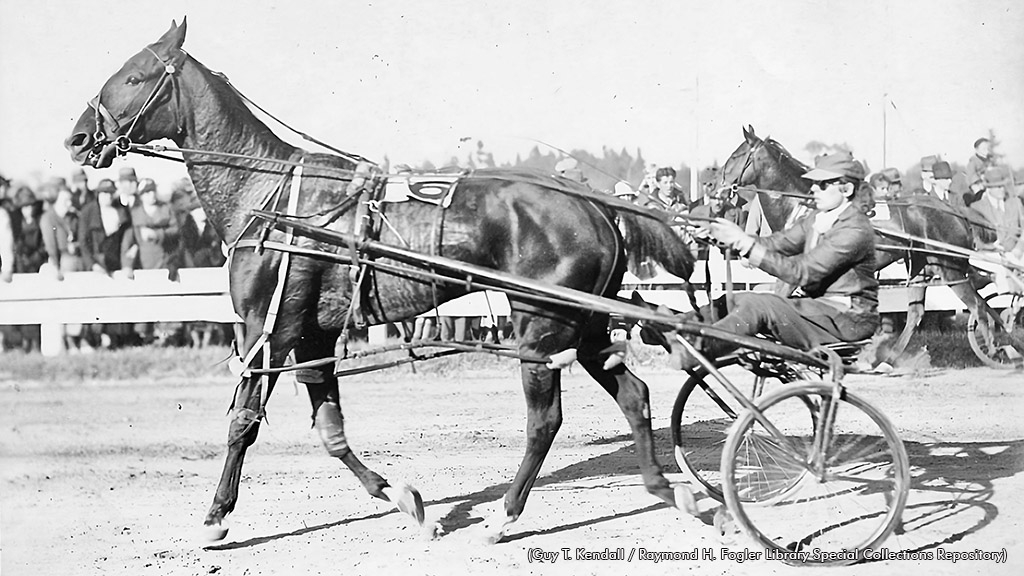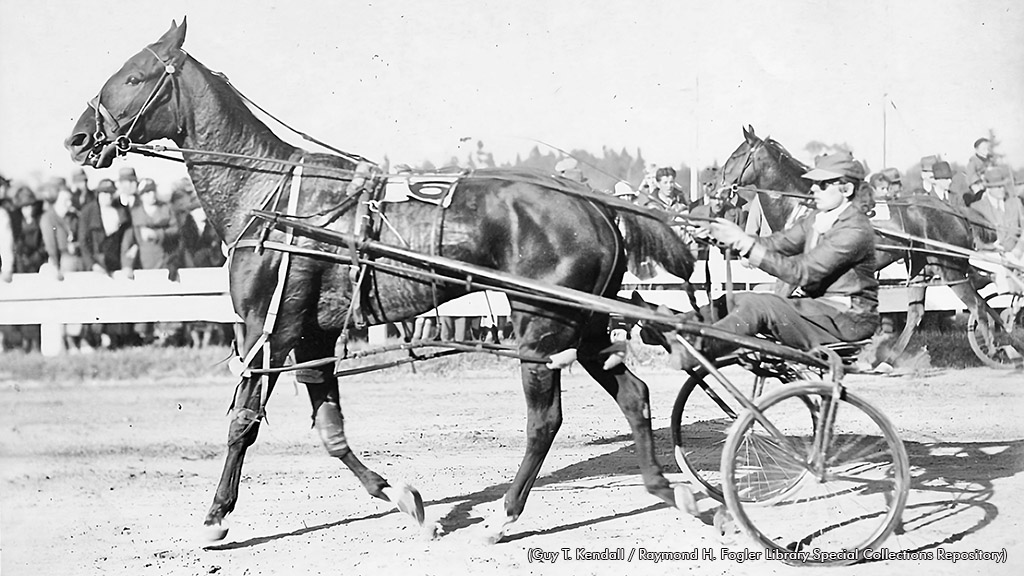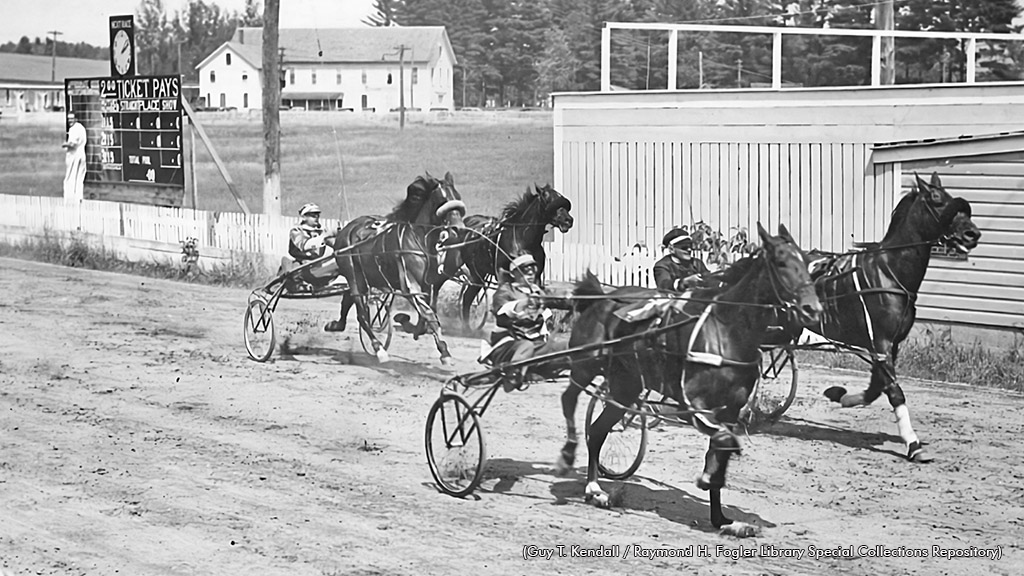
In 1935, the big news at the Topsham Fair in Maine wasn’t the debut of pari-mutuel wagering. It was 19-year-old Vergery Luella Carson, a barnstorming harness racing sensation from upstate Lewis, New York, said to be the only female driver in the United States at the time.
She arrived at Topsham that year with fanfare, a teenager racing around the New England fair circuit, beginning her 1935 campaign in Vermont. At Rutland, it was reported that she was the first woman “to drive her own horses” at the fair.
Winless early in the fair season, she broke through at Tunbridge, setting the track record on Sept. 18 with her pint-sized gelding, Gilded Braden, in 2:12 1/2. She also won with her front-running mare, Lady Patch, after which she was given a “beautiful bouquet of flowers by the fair officials,” reported the Herald and News of Randolph, Vermont.
Heading to Maine in early October, she tied the 2:09 1/2 track record at the Acton and Shapleigh Fair in early October with her bay gelding Dillon Direct, after which she was "carried from the track on the shoulders of her admirers and received a grand ovation from the fans,” said the Sanford Tribute and Advocate.
All of which set the stage for Topsham, where “never before has so large a collection of race horses been quartered in recent years,” reported the Lewiston Daily Sun, and where fans, and many women supporters, flocked to see Vergery Carson, “the only feminine light harness pilot in New England.”
And she did not disappoint.
“Woman driver thrills crowd on opening day,” shouted the headline in the Lewiston paper on Oct. 9. “Miss Carson was curiously regarded by the old-timers,” reported The Brunswick Record in its euphoric story about her opening day exploits. “Even the announcer emphasized the ‘Miss’ when he named her.”
And when Carson’s name was announced, the crowd gasped. “It was a sensation,” the paper reported. She wore green and brown silks, “her hair streaming from under a driver’s long peaked cap, yellow goggles obscuring her very good eyes, and her whip hand as capable as Simon Legree’s.”
Carson rose to the occasion, winning two races on opening day with Lady Patch, her bay mare by Knight Patch.
Back then, one “race” usually meant three heats involving the same horses, and Lady Patch and Carson raced in the second, fifth and eighth races on opening day. In her first heat, she finished seventh. Not surprising, she went off at 13–1 in her second heat.
While “the ladies flocked on Miss Carson…the male bettors for the most stayed away,” the Lewiston paper reported.
At the start of the second heat, “Miss Carson cut in, took the pole, and kept it all the way around,” winning by a length over Faro and paying $28.20 to win.
“Miss Carson was given a great hand when she drove to the judges’ stand to acknowledge her victory,” the paper noted, adding that “the idea of having one of their own sex riding on the sulky appealed to the woman folks.” One woman from Auburn was quoted as saying, “If that girl can ride a sulky and take such chances, I’m willing to take a chance with two dollars of my money.”
Her win in the third heat was much closer and “the best race of the entire program” as Carson again held off the black gelding Faro in a very close finish. “It was only Miss Carson’s whip which accounted for Lady Patch’s win.”
But so often in racing, highs are paired with lows.
The next day, Carson was involved in a horrific pileup along Topsham’s paddock turn. Heading past the half, the lead horse stumbled and fell, setting off the inevitable chain reaction. Racing third with Gilded Braden, Carson was catapulted from her sulky, landing on the track.
Bleeding from a severe cut on her forehead and suffering cracked ribs, “Miss Carson was seen to arise and stagger to the low fence and crawl over this into the infield,” according to the Lewiston paper. Another driver, William Donnelly, suffered a concussion (no helmets in those days). In all, four horses and drivers were involved. The horse that fell, Zymri, was put down.
Carson recovered, and in 1936, again raced all around New England, winning at the Oxford Fair with Gilded Braden, the pacer involved in the Topsham accident.
In fact, Carson was a year-round harness driver, competing on ice-covered lakes in upstate New York during the winters. During the summer and fall, she raced mostly at Vermont and Maine fairs.
But on Sept. 9, 1936, while driving at the Rutland, Vermont fair, Carson fell ill. She died on Oct. 3, 1936 at a Plattsburg, New York hospital. She was 20 years old.
A tribute in the Lake Placid News noted that “her judgment and fair play was greatly respected even by the griseled old-time horse handlers against whom she competed very often successfully.” She is buried in the Lewis Center Cemetery.

Vergery Carson parades Gilded Braden prior to the fourth race on Oct. 9, 1935, at the Topsham Fair. In that race, a pileup after the half left Carson with broken ribs and a cut forehead.

Vergery Carson drives Gilded Braden to a win in the first race of the Oxford County Fair at Norway and South Paris, Maine, on July 22, 1936. Carson and the black pacer were involved in the tragic accident at Topsham the year before.
(Jay Burns / Topsham Fair)


A nice old story
This is a great old story that unfortunately had a very sad ending. The area where this took place is steeped in harness racing history and in some ways resembles our Canadian past. Thankfully many old pictures remain as well as accounts of yesteryear's race days. Thanks to Jay Burns for providing this story.